This post contains affiliate links.
Empathy is a key ability and board games are a surprisingly good tool to help foster this quality. This is what motivated me to write this post, especially “Feelinks,” which is really special, as well as “Knowsy” that I discovered while searching the topic. These are both great ways of building empathy and trust with your relatives.
I could find 10 different empathy-building board games that I can recommend. They generally fall into three categories:
- Games primarily aimed at parents with 5 year-olds and up that help build basic empathy skills such as “Social Skills Board Games,” “Caring Cats,” or “6 Social Skills Games”
- Games mainly for education professionals that go deeper in the components of empathy such as “Snoots Toots,” “The Social and Emotional Competence Game” & “Social Skills”
- “Real” Games that are aimed at adults such as “The Empathy Toy,” “Feelinks” and “Knowsy“
Empathy Board Game Comparison Table
| Game | Age | Price | Home | School | Therapy | Counsel | Orgs | Rating |
|---|---|---|---|---|---|---|---|---|
| Friends & Neighbors | 2‑4 | $$ | X | X | ★★★☆☆ | |||
| Social Skills Board Game | 5‑8 | $$ | X | X | X | ★★★★☆ | ||
| Caring Cats | 5‑8 | $$$ | X | X | ★★★☆☆ | |||
| 6 Social Skills Games | 5‑6 | $$$ | X | ★★★☆☆ | ||||
| Snoots Toots | 6‑8 | $$$ | X | X | ★★★☆☆ | |||
| Social Skills | 6‑10 | $$$ | X | X | X | X | ★★★★★ | |
| The Empathy Toy | 6+ | $$$$$ | X | X | ★★★☆☆ | |||
| The Social & Emotional Competence Game | 6‑14 | $$$$ | X | X | ★★★★★ | |||
| Feelinks | 10+ | $$$ | X | X | ★★★★★ | |||
| Knowsy | 12+ | $$$$ | X | X | ★★★★☆ |
Remark : “Orgs” stands for Organizations
Now let’s look in detail at these games. I have classed them according to their minimum recommended age:
Preschool & Kindergarten Empathy Board Games For Children
You can find the preschool and kindergarten competencies according to the Massachusetts standard and the games that I found to best contribute to increasing these competencies at the end of this post.
Friends and Neighbors (Peaceable Kingdom/Mindware)
★★★☆☆
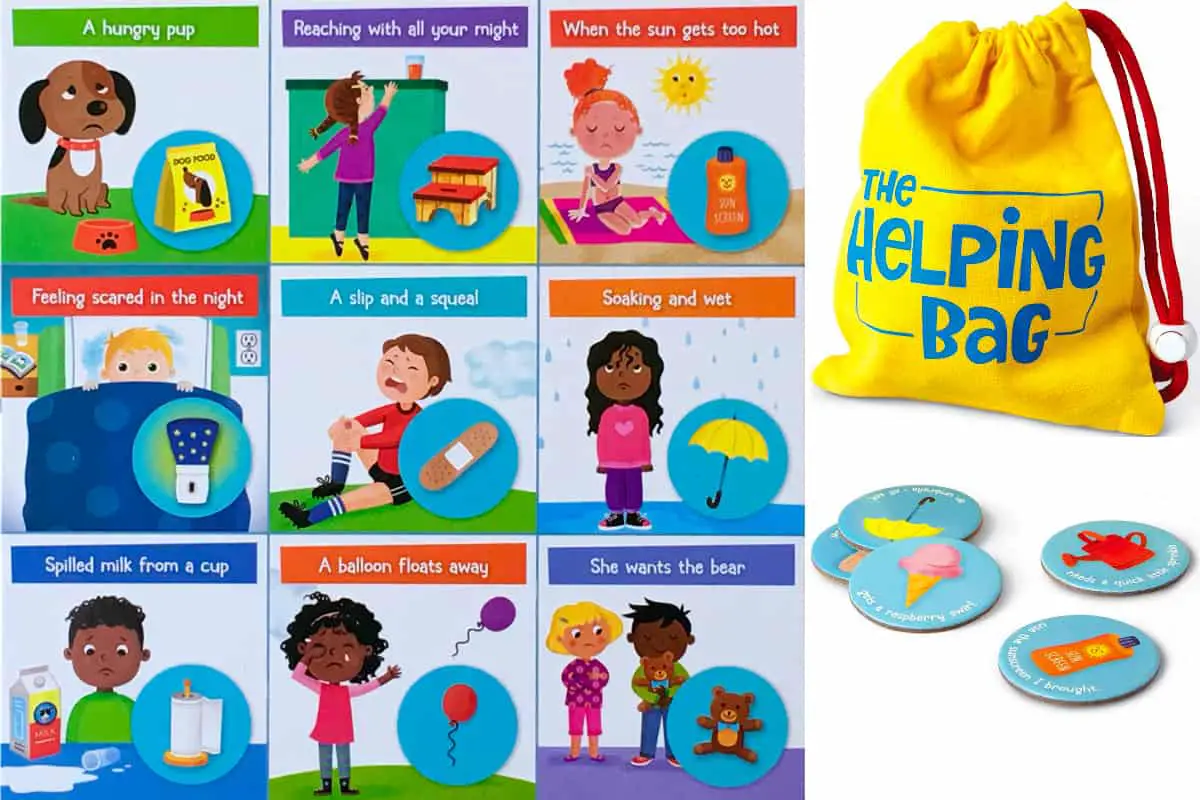
Age: 2-4 in my opinion (3+ for the editor)
Players: 1-4
Target: Family, Therapists
Duration: 10 mn
Author: Shannon Lyon, Marisa Pena
I recommend Friends and Neighbors for use at home or by therapists for Kindergarten and Preschool because it has the following advantages:
for use at home or by therapists for Kindergarten and Preschool because it has the following advantages:
- It is a cooperative game, which is best for this age-range and is in tune with the objective of the game to develop empathy
- The short duration makes it viable for these ages
- The principle is very simple: on each of the 4 gameboards, you have 9 characters who experience a problem. You draw one of the 14 “solution” tokens and try to match it with one of the characters. If you can match it, you put it on the character, or else you put it on a card with a stop sign.
- You have a storybook with explanations for each problem/situation.
- You can play the game with one child
- A nice design
- Affordable
But it is necessary to completely change the rule. With the existing rule:
- You only do “visual matching” and you do not work on empathy at all
- There is one predetermined “solution” for every problem/situation, which completely hinders the problem-solving ability and creativity that you want the child to learn if they are to develop real empathy.
So, instead of putting the focus on matching tokens with characters, you should focus on having the children (or child):
- Describe a situation
- Describe the corresponding emotion (for instance the child afraid of the dark)
- Propose potential solutions. If they come up with a viable solution, they win. To make the game more interesting, they then look for the matching token and compare their best solution with that of the token (and most of the time, they will come up with better solutions)! That, in turn, will enable you to emphasize the importance of them thinking by themselves and finding “better” solutions than the canned ones suggested.
So, my recommendation is to completely inverse the rule of the game to make it work and really contribute to developing empathy.
You also have to keep in mind the limitations of the game, which are why I recommend it up to 5 year-olds at most. For older children, the game is much too simplistic:
- The situations are very “basic.” The child needs something (an umbrella for the rain) and if you give it to him/her you “solve” the problem. This is not how real needs work most of the time. Needs are mostly psychological, and based on relationship issues, rather than purely physical.
- There are only 14 different situations in the game (repeated several times on the 4 boards)
Also, keep in mind that an adult is needed to identify the emotion that the children might feel, read the text or comment on the proposed solutions.
Social Skills Board Games (Junior Learning)
★★★★☆
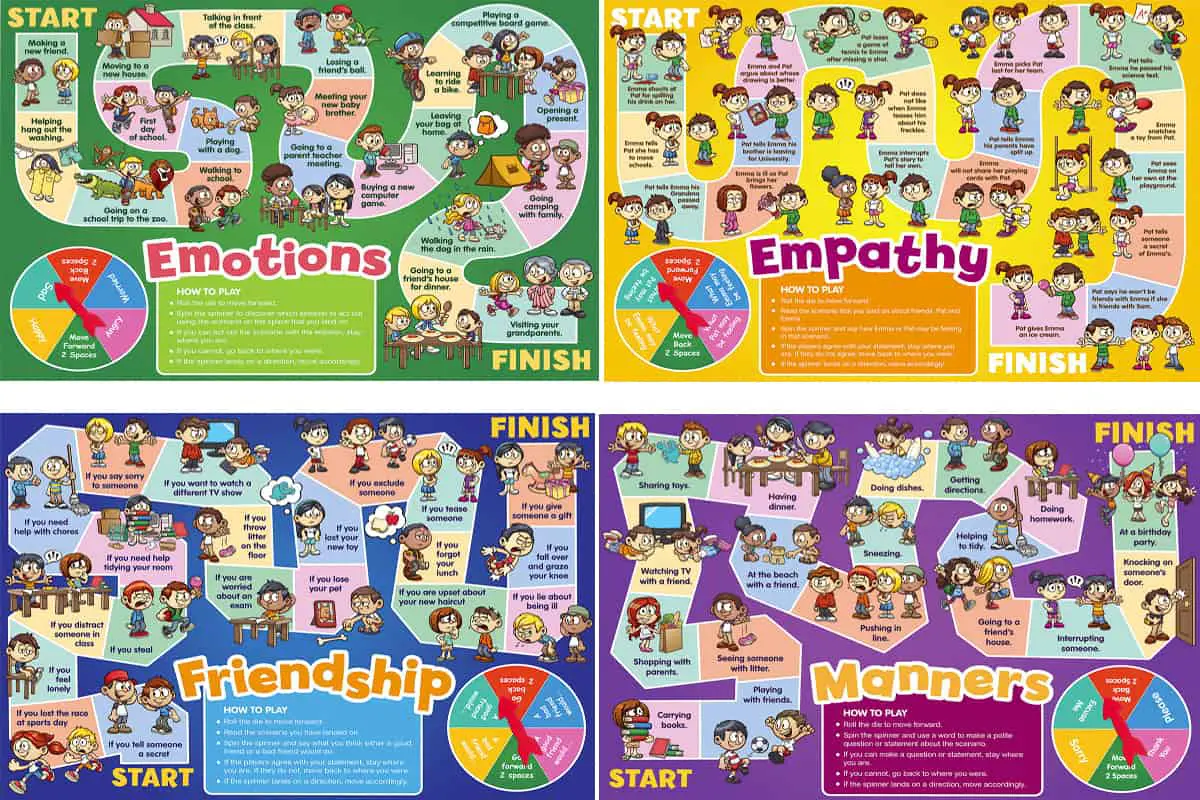
Age: 5+ (5-8 for me)
Players: 2-6
Target: Families, School
Duration: 30 minutes
Social Skills Board Games is comprised of 4 gameboards, each aimed at developing a specific skill, as described below:
is comprised of 4 gameboards, each aimed at developing a specific skill, as described below:
- Emotions: you act out 4 emotions drawn with a spinner (sad, happy, angry, worried) combined in one of the 20 situations of the board (80 possibilities)
- Empathy: you try to guess how one of the two characters may feel in one of the 20 scenarios (40 possibilities)
- Manners: you use a word drawn with a spinner (Excuse me, Sorry, Please, Thank you) in one of the 20 situations of the board to make a polite statement or question about the situation (80 possibilities)
- Friendship: you tell what you think a bad or a good friend might do in one of the 20 situations (40 possibilities)
I really like many things about this game because:
- The 4 boards are well-illustrated
- The rules are written on each board, which makes them impossible to lose (and they are really, very simple)
- The combination of (4 boards) x (20 situations per board) x (the spinner) means that there is a lot of variability and replayability in the game
- Affordable
- The answer sheet included
- It can be used with autonomous groups of children, so it is relevant to use it in the classroom. For instance, if you create 4 groups, each group playing with one of the 4 boards, then you can have 16 children playing together with one game.
So, I highly recommend it for children from 5-8-year-olds both at home or at school.
The main drawback: in my opinion, 4 emotions are too limiting because at this age children can handle at least 15 different emotions.
Caring Cats – Kindness Around Town (Chalk and Chuckles)
★★★☆☆
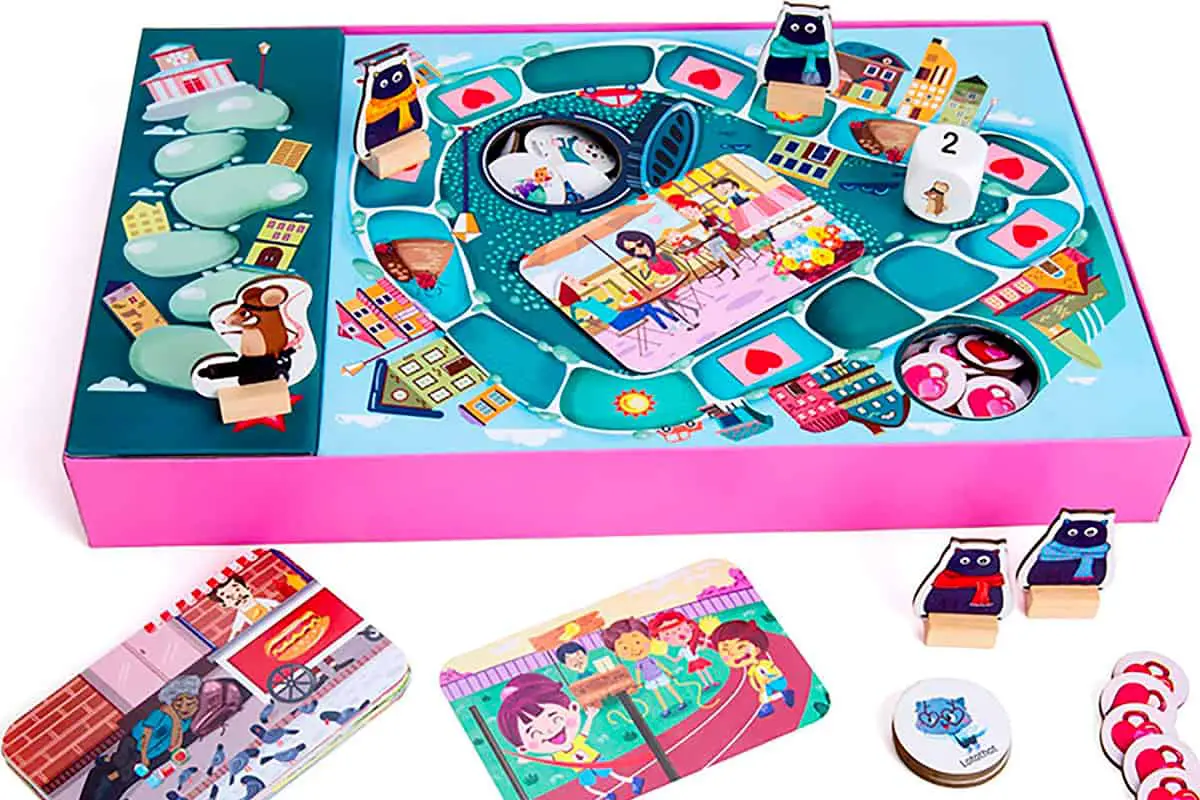
Age: 5-8
Players: 2 to 4
Target: Parents, Therapists
In Caring Cats – Kindness Around Town, children draw situation picture cards and propose acts of kindness (helping, sharing, giving, making, saying thoughtful words). Each act of kindness corresponds to the situation and caring style of 5 cats, allowing them to win “charms.” There are two rules:
– Kindness Around Town, children draw situation picture cards and propose acts of kindness (helping, sharing, giving, making, saying thoughtful words). Each act of kindness corresponds to the situation and caring style of 5 cats, allowing them to win “charms.” There are two rules:
- The cooperative rule is played against the “mean mouse”
- With the competitive rule, the player to first collect 5 “charms” wins
In my opinion, here are the pros and cons of the game:
- Very cute illustrations
- The cards have well-illustrated situations that trigger discussion to describe it and propose the “acts of kindness.” The fact that the situations are not described by a text but by an illustration is a very strong point for children ages 5-7 who cannot read complex text
- The fact that each “caring style” is represented by a different cat is a nice idea but can be confusing because you have to remember their names
- There are different possible acts of kindness for each card. You have to make this clear to the players, or they will try to find the “right” solution (explain to them that there are different “good” solutions, not just one)
- This also leads to the importance of the role of the parent or therapist in the game. They will validate the acts proposed by the children (or they will be frustrated because they will not know if their proposal is “correct”), so their role is absolutely crucial. The adult must be a good facilitator, which is why the games work well for therapists for instance but not with all parents.
I recommend this game if you are ready to play the facilitator with the children of ages 5-8.
6 Social Skills Games (Junior Learning)
★★★☆☆
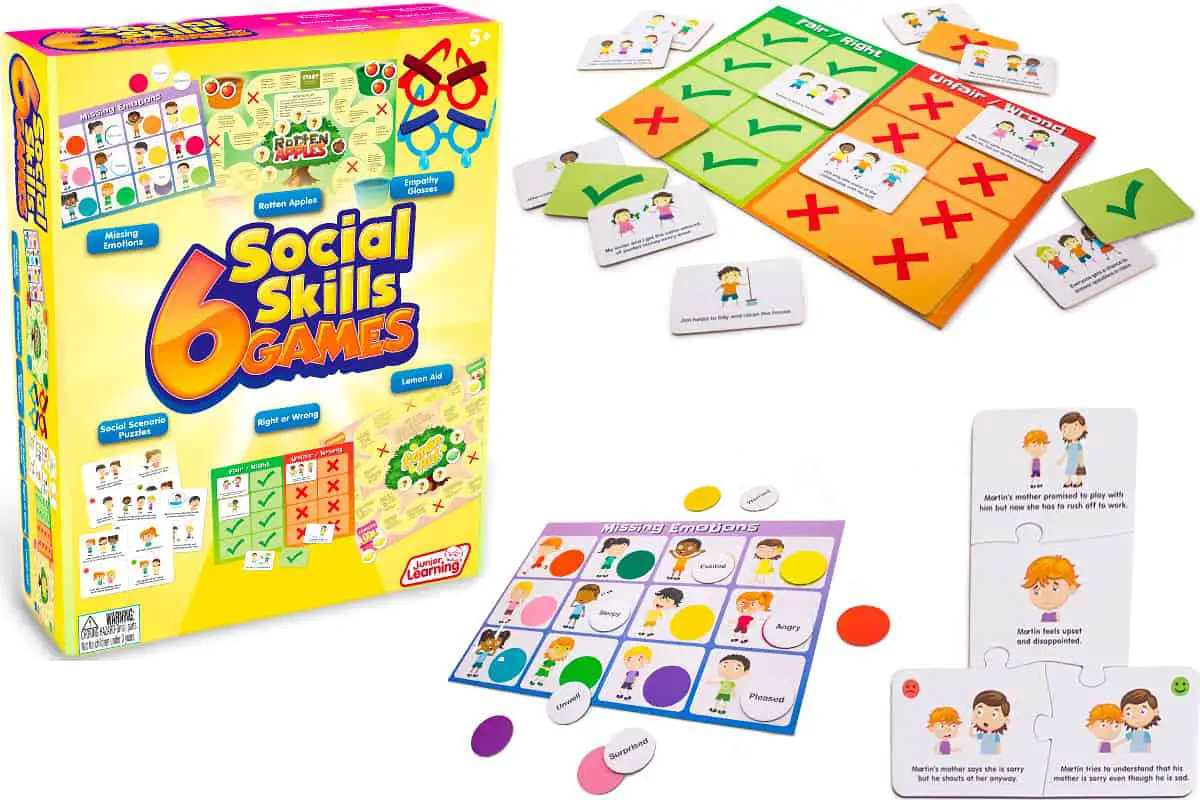
Age: 6+ (my recommendation: 5/6)
Players: 1-4
Target: Families
Duration: 10 minutes for the small games, 30 minutes for the board games
6 Social Skills Games by Junior Learning is comprised of two board games and 4 small games.
by Junior Learning is comprised of two board games and 4 small games.
The four small games cover themes such as:
- Right or Wrong: Morals: Players have 16 rectangular, thick cardboard tokens that each describe an action (with a small illustration). Players have to put each action token on the board either on the “Fair/Right” side or on the “Unfair/Wrong” side. The match can be checked with the color-coding of the back of the token, enabling players to play autonomously. Each positive action has its corresponding negative action.
- Empathy Glasses: Showing emotions: Players wear one of six cardboard glasses that show a specific emotional state (surprised, sad, angry, etc.). This facilitates role-playing and makes it more fun.
- Missing Emotions: Recognizing emotions: Players match 12 emotions written on small, round tokens with 12 characters that each show an emotion on a board. The matching can be checked with the color-coding on the back of each token, which provides auto-correction by the players and enables them to play autonomously (Unwell, Worried, Angry, Pleased, Surprised, Excited, Sleepy, etc.).
- Social Scenario Puzzles: Managing emotions: Small puzzles (4 pieces per puzzle) tell small emotional stories. In each puzzle:
- The first piece describes the situation
- The second piece describes the negative emotion/feeling of the main character triggered by the situation
- The third (red emoji) and fourth (green emoji) pieces respectively describe how the main character can handle the situation, in a non-effective way, that aggravates the original emotion, or in an effective way, that soothes the negative emotion
The rules of the two board games are simple and directly printed on the board. 20 Questions are written on the board’s path (with two possible answers) and are answered by the players when they stop on the corresponding box. Each player has a token and progresses with a dice. Other tokens are collected by players according to their responses.
- Rotten Apples: Friendship: The answers to the 20 questions are very basic and do not generally leave room for giving the “wrong” answer (i.e. it is important for a friend to be: (A) “Kind,” or (B) “Mean,” etc.).
It is not bad to remind the players of some obvious basics about friendship, but I find this disappointing that there is no challenge for two reasons: firstly, this “Rotten Apples” board game leaves very little room for learning anything new. After all, if friendship was so easy and so obvious, we would all have many great friends. Secondly, it makes the game boring because the answers are so obvious. Another problem with this game principle is that it leaves no room for creativity. Hence, I would recommend this board game only with an adult who will use the “stupid” questions to trigger meaningful discussions with the players. - Lemon Aid: Manners: The principle is the same as “Rotten Apples,” with very basic and unequivocal questions such as “It is raining heavily and you see someone getting wet. It would be helpful to: (A) “Offer for them to stand under your umbrella” or (B) “Ignore them.” So, I have the same reservations concerning this game as with “Rotten Apples.” I would play it only with very small children, and use it as a pretext to create a discussion.
Overall, I do recommend this game: in a family setting only (too basic for school, and an adult is necessary to create a discussion), with very small children (5-7 Year-olds at most), and mainly as a pretext to trigger discussions with them.
Empathy Board Games for Elementary School Children & up
At primary school level, more advanced empathy-related competencies can be developed. For instance, empathy can become an explicit tool to avoid potential aggression from others (not just a way to avoid being aggressive with others).
Snoots Toots – A Kid’s Game of Empathy and Manners (Youthlight)
★★★☆☆
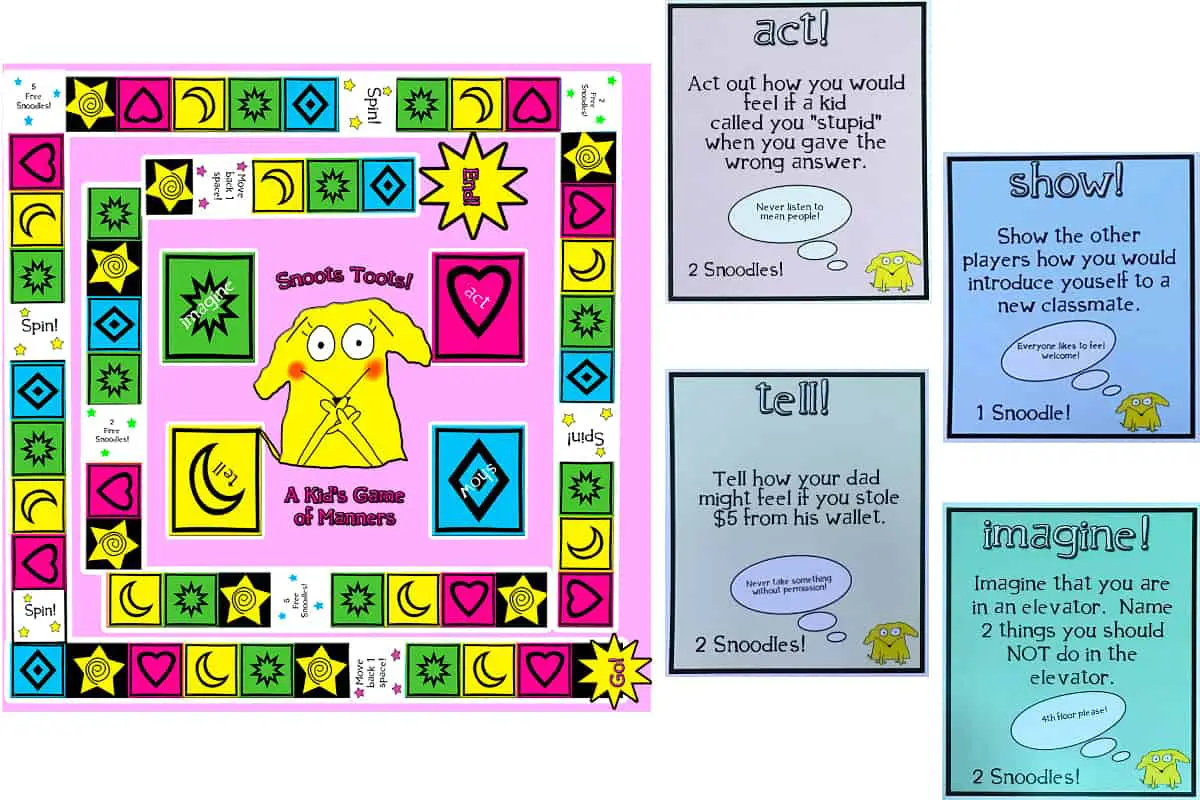
Age: 6-8 (6-12 for the editor)
Players: 2-5
Target: Family (but a bit too expensive), or Counseling at School (maybe a bit too basic and difficult to manage a progression)
Duration: 50 minutes
Author: Poppy Moon
In Snoots Toots , kids answer questions and role-play in situations requiring manners and empathy skills. There are four types of questions:
, kids answer questions and role-play in situations requiring manners and empathy skills. There are four types of questions:
- Imagine: the child has to describe how a character would feel, or what that character should do in a given situation.
- Tell: the child has to tell things to do that are relevant in the given situation, explain why some actions are relevant, or how a character would feel in a given situation
- Show: Show what to do or not to do in a given situation
- Act: Act out what to do or not to do in a given situation, or how you feel in this situation
As you have probably realized, “Imagine” and “Tell” are in fact the same, while “Show” and “Act” are also similar. It would have been better, in my opinion, to create 4 categories of questions that would really be different; for teachers or parents, this would have enabled them to easily create more specific variations of the game with a progression.
Some of the questions are about school-related situations, while the majority are about general or family settings. These types of situations are not color-coded or classified in any way, which makes it difficult to use the game for a specific objective.
Another remark I have to make is that the skills and situations are rather basic ones in most cases. Although the game is certainly useful, it will not be relevant for older children, which is the reason why I consider it to be more of a game for 6-8 year olds, rather than 6-12 year-olds (publisher’s recommendation), and certainly not a fit for Middle School children.
I do recommend this game mainly for school counseling or therapy, but do not expect more than it really conveys. The game is at its best with 1st to 3rd-grade students and is more for teaching general manners than empathy (even if there are elements that contribute to building empathy).
Social Skills (SmartKids) – 6 Board Games
★★★★★

Age: 6-10
Players: 2 to 4
Target: families, schools, therapy
Duration: 30 minutes
Social Skills by SmartKids is comprised of 6 board games. Each game has a very simple rule written on the board itself and aims at practicing a specific competence. The principle of the games are to explain what you would do or your point of view and progress in the game if the other players agree with you. The games and competencies are the following:
by SmartKids is comprised of 6 board games. Each game has a very simple rule written on the board itself and aims at practicing a specific competence. The principle of the games are to explain what you would do or your point of view and progress in the game if the other players agree with you. The games and competencies are the following:
- What Would You Do? (Morals): The board comprises of 39 open-end situations such as: “You want to join in a game with some other kids” or “You see two kids fighting at lunchtime.” When they land on a square, players have to say what they would do in this situation. They stay on the square if the other players agree with the answer, and return to their previous position if they do not. Most situations are personal or family-related (some are school-related), and allow for different potential attitudes (which makes them good triggers for discussion).
- Manners (Manners): The board comprises of 32 scenarios, and players have to explain if the scenario they land on shows good or bad manners (i.e., You need to sneeze but don’t have a tissue so use the bottom of your shirt). The answers are quite straightforward, so it is much less interesting than “What Would You Do?”
- How Others Feel (Empathy): When they land on an “Emotion” square, players have to tell the other players about a situation when they saw someone feeling that emotion. The principle is very good as it lends itself to very diverse answers and requires thinking about the emotional responses of other people. I just regret that there are only 6 emotions on the board (Happy, Nervous, Angry, Proud, Exited, or Sad). Children at that age are able to differentiate at least 15 different emotions, and it would have been easy to design the board to handle them.
- What Makes a Good Friend? (Friendship): When they land on one of the 25 “positive” squares, players have to tell the other players of a time when a friend displayed the characteristic written on the square (such as “Good listener,” “Cheers you up,” “Generous”). When they land on one of the 5 “negative” squares, they have to discuss why the attitude described makes a bad friend (for instance “You tell someone else your friend’s secret”). This game is very good, as the positive characteristics are well-chosen and general enough to find real-life examples.
- Acting Out (Showing Emotions): When they land on one of the 27 squares, players spin the arrow on the spinner and act out the sentence written on the square using the emotion given by the spinner (among “Happy,” “Angry”, “Sad,” “Surprised,” “Worried” and “Excited”). Examples of sentences are: “I can see a shark in the sea,” “I fell off my bike” or “Sarah is bouncing on her ball”. I find that this game is very good, as it forces both the current player to act out realistically and the other players to assess if the acting was convincing.
- Mountain Of Emotions (Managing Emotions): When they land on one of the 34 squares, players say what would make them feel like the emotion or the attitude written on the square (i.e., “grumpy”, “helpful,” “excited,” “clever,” “proud”). The game is not a bad one, but it does not help in managing emotions, as it only handles describing situations that trigger the emotion. So, it is deceptive to pretend the game is about “managing emotions.” The other problem is that the squares mix emotions and feelings. It would have been much better to distinguish them as a feeling of loneliness that can trigger different emotions (“anger” if you think that others have let you alone without a reason, “nervous” if you do not know what to do, “calm” if you needed this loneliness to think). The game “works” of course, but can result in a lot of confusion for the players about what emotions and feelings are and how they interact. To solve this problem, I recommend that you: mark the feelings squares with a permanent marker and change the rule for feeling squares (i.e., players explain what emotion this feeling would trigger for them).
Hence, I highly recommend this game for schools, families, therapy or counseling with children aged 6-10 (1st grade to 5th grade).
You can improve the game by making it more cooperative. For example, drop “Manners” and change the rule of “Mountain of Emotions.” I would say to let the players work together to help the current player solve each social challenge question (instead of just judging if the answer is their answer is “good” or “correct”), and of course, eliminate the “winner” in favor of having everybody finish the game.
The strength of this game is that it encourages discussions to find relevant manners, attitudes and much more.
The Empathy Toy (Twenty One Toys) – Teacher’s Kit
★★★☆☆
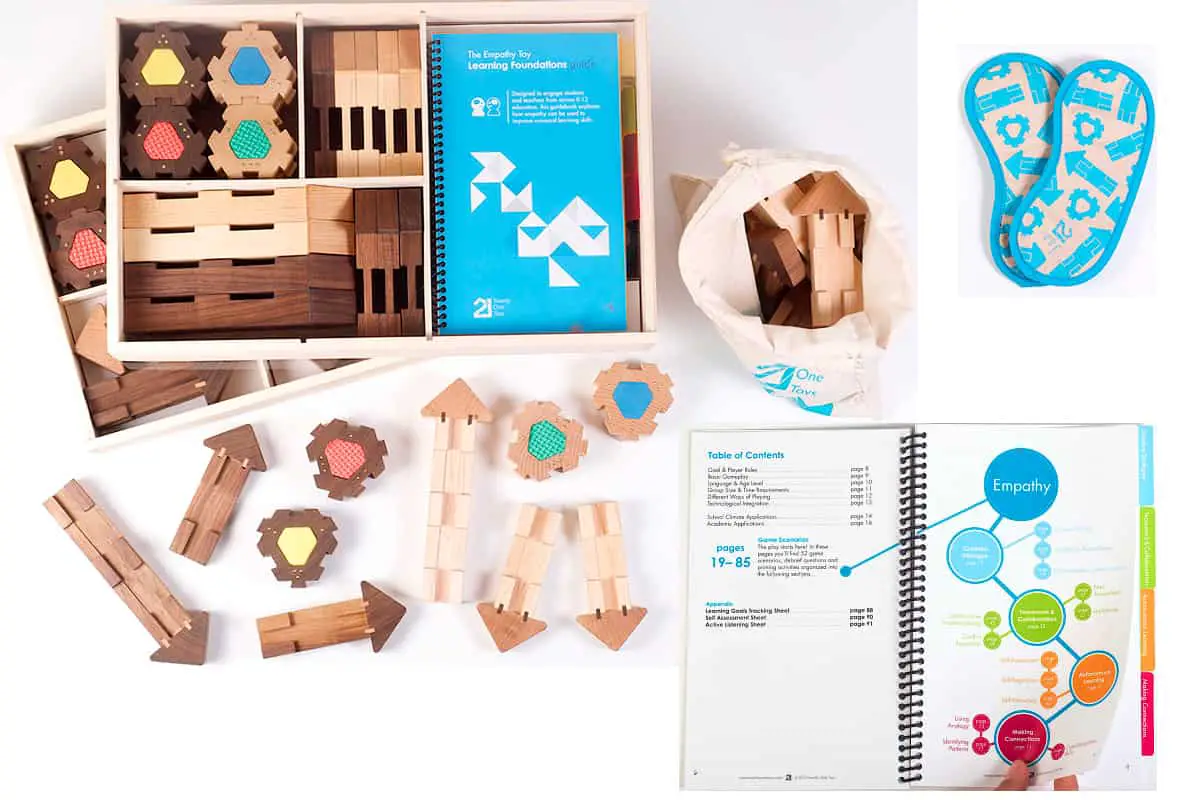
Age: 6+
Players: 3-20
Target: Schools, companies
Duration: 5 to 20 minutes
Author: Ilana Ben-Ari.
The Empathy Toy was originally designed with visually impaired players in mind (you play blindfolded), but the principle of the game turned out to be universal and interesting for everyone.
was originally designed with visually impaired players in mind (you play blindfolded), but the principle of the game turned out to be universal and interesting for everyone.
It is a wooden puzzle that you must complete together blindfolded (there are many possibilities, in fact 52 game scenarios). Each toy piece is different. One player assembles some pieces together. Then the other players work together to create the same shape (with the same pieces)! To succeed players need to clearly communicate and understand the difficulties that other players have in completing the puzzle.
Rather than empathy (like the game advertises), the game is about efficient communication and collaboration, which is a critical capability in many situations (both personal and professional).
The “Empathy Toy” is hyped up (boosted by clever marketing)! I do recommend it if you have the budget. Just to keep in mind:
- The principle is not that new:
- There are many blindfolded group activities that require efficient communication to be completed, and that cost nothing (except the blindfolds that you can make with simple scarves). Look for “blindfolded game” on the Internet to find dozens of ideas
- The classical “Draw-it” game that I describe in my post about Art History printed Flashcards works in a similar way
- You can play the same game with construction cubes or legos.
- You are going to work on improving clear communication to achieve efficient collaboration (which is of course very important), not primarily about building empathy. If you want to specifically target empathy, choose another of the games on this page.
The Social & Emotional Competence Game (ChildTherapyToys)
★★★★★
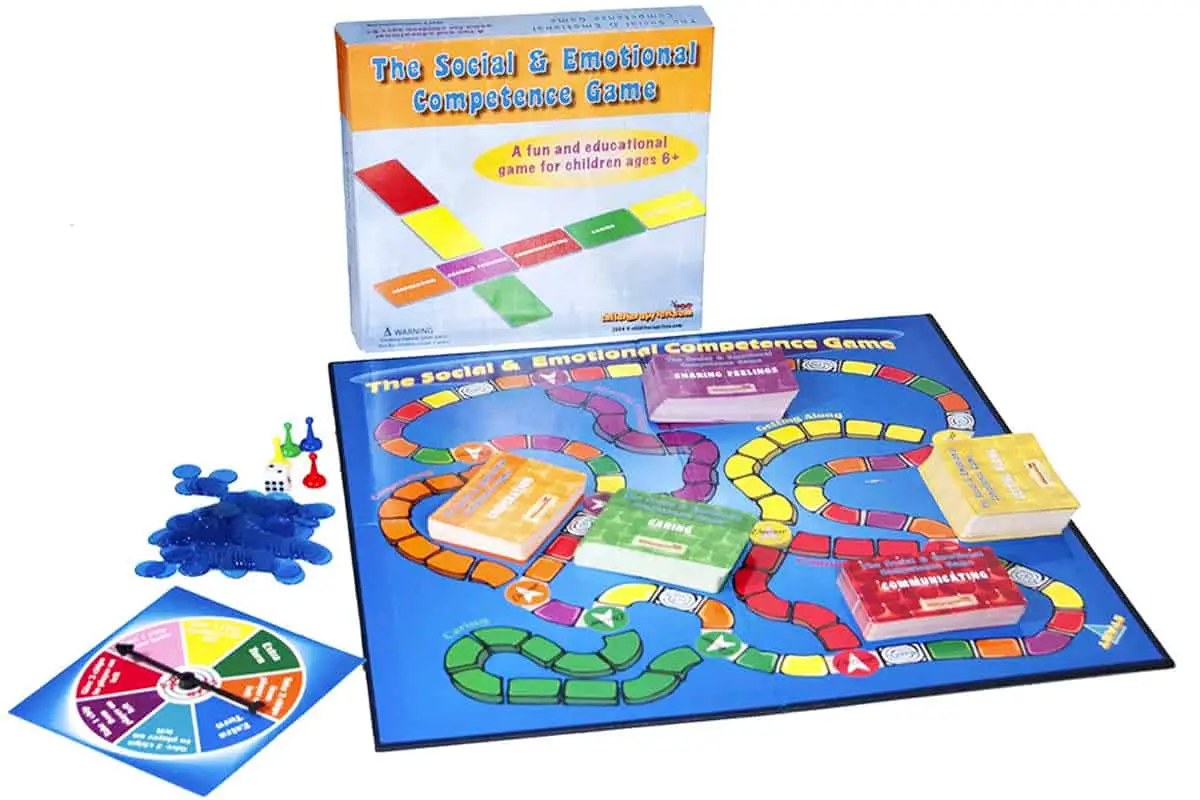
Age: 6-14
Players: 2 to 6.
Target: therapists, counselors
The Social & Emotional Competence Game is a “classic” SEL competence (and other SEL competence) building game that is best suited for use by teachers, therapists and counselors.
is a “classic” SEL competence (and other SEL competence) building game that is best suited for use by teachers, therapists and counselors.
The game comprises of squares with 5 colors that correspond to 5 colored card decks (each card that you draw having an instruction that you have to follow to win chips). There is also a spinner:
- “Caring” cards (Green) – for instance “How can you show your friends that you care about them? One chip.”
- “Sharing Feelings” cards (Purple) – for instance, “How might a child feel when their parent tells them that a grandparent has died? One chip. ”
- “Cooperation” cards (Orange) – for instance, “Why do children want to have friends? One chip.”
- “Getting Along” cards (Yellow) – for instance, “Rachel’s parents just told her they are going to have a new baby. She is not sure she wants a new baby in the family. Do you think she should talk to her parents? What should she say? Three chips.”
- “Communicating” cards (Pink) – for instance, “Who is your favorite relative? Why? Two chips.”
The instructions on each card are well thought out (the author, Gary Yorke, is the founder of ChildTherapyToys and a child psychologist). Although they are not specifically designed to build empathy, the general categories addressed require a certain level of empathy, which is why I included the game in this post.
As you can see with the examples:
- The 5 card categories are rather broad and overlap. They enable players to sort cards in order to focus on specific competencies, although this is made a bit fuzzy by the overlapping card categories
- There are easier and more difficult cards according to the number of chips. This enables players to manage the difficulty of the game.
- The questions on the cards trigger discussions because they are about specific issues that are emotionally relevant for children
Overall, I highly recommend this game which is an appreciated “classic” in SEL competencies building.
Another important point, the “The Social and Emotional Competence Card Game ,” another game also proposed by ChildTherapyToys can be played alone, or as complementary cards with the board game, and they are specifically designed for children with ADHD, Asperger’s, Anxiety, Depression or Bipolar Disorder.
,” another game also proposed by ChildTherapyToys can be played alone, or as complementary cards with the board game, and they are specifically designed for children with ADHD, Asperger’s, Anxiety, Depression or Bipolar Disorder.
Note that the start of the game is on the bottom right of the board (not intuitive!) and that the game does not have a specific aim and end.
I propose that you decide on one of the following variations beforehand (or any other variation that you might think of):
- There is a specific duration at which the game stops, the player with the most chips wins
- The first player who collects a specific number of chips wins
- (Cooperative version) The chips are won together. If 20 chips are won in less than 20 minutes, then all the players win
This will contribute to make the game a bit more fun (because there will be a specific objective that the players will try to achieve).
Other Options
- Stars Of Empathy
 is a game from the Netherlands that is interesting in that it really engages the children by asking them personal questions (i.e, : Who is your best friend? What makes him or her special?), giving tasks that involve interaction between the players (Give the player on your left a compliment). It is played in a group of 4 children plus a supervisor and is recommended for children aged 8 to 12. The caveat: the game costs €50 plus shipping from Europe (not sold on US-based e-commerce websites). Stars Of Empathy is an interesting option for professionals, but generally will be too expensive for parents to try.
is a game from the Netherlands that is interesting in that it really engages the children by asking them personal questions (i.e, : Who is your best friend? What makes him or her special?), giving tasks that involve interaction between the players (Give the player on your left a compliment). It is played in a group of 4 children plus a supervisor and is recommended for children aged 8 to 12. The caveat: the game costs €50 plus shipping from Europe (not sold on US-based e-commerce websites). Stars Of Empathy is an interesting option for professionals, but generally will be too expensive for parents to try. - Empathy Counts
 by Franklin Learning Systems aims at merging a domino game with empathy-building open question cards. The problem is that the domino game and the question cards are completely independent from one another. Answering a question card before playing a domino feels pointless, as it does not alter in any way the domino game. So, if you want to play a game of empathy-building open question cards, chose a card game instead (it will be less expensive and more effective).
by Franklin Learning Systems aims at merging a domino game with empathy-building open question cards. The problem is that the domino game and the question cards are completely independent from one another. Answering a question card before playing a domino feels pointless, as it does not alter in any way the domino game. So, if you want to play a game of empathy-building open question cards, chose a card game instead (it will be less expensive and more effective).
Empathy Board Games for Middle School Children & Up
Feelinks (Social Sloth Games)
★★★★★
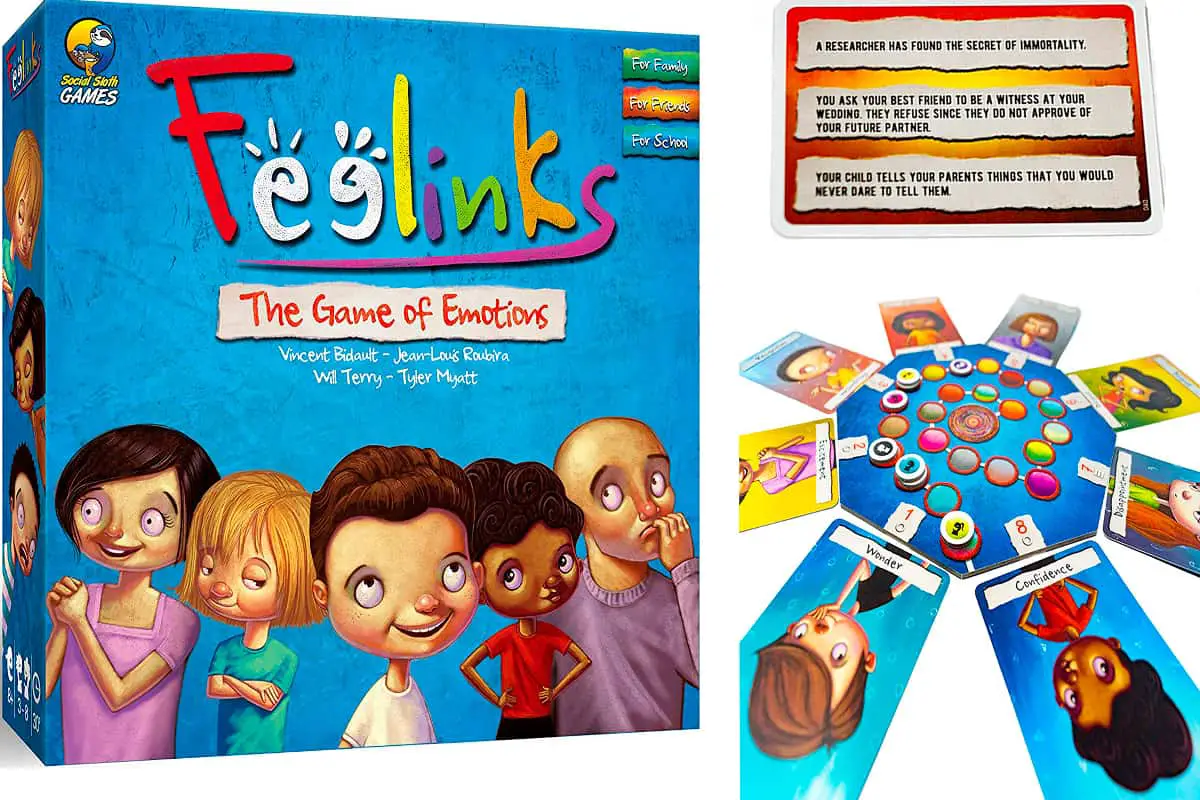
Age: 10+
Players: 3-8
Target: Friends / Families / Schools (small groups)
Playing time: 20-40 minutes
Authors: Vincent Bidault, Jean-Louis Roubira
Feelinks (the new version by Social Sloth Games or the older one) is a really unique game. I consider it the only “must-have” empathy-building game of this whole post.
(the new version by Social Sloth Games or the older one) is a really unique game. I consider it the only “must-have” empathy-building game of this whole post.
Most “game nerds” hate educational games because they do not find them fun enough (they perceive them as disguised exercises) nor challenging (the rules being intentionally simple and non-competitive).
But Feelinks has succeeded in being:
- A “real party game” that gamers love and can play over and over again
- A “real educational game” that truly “teaches” empathy
- A game that fights against discriminations and preconceptions
How is this even possible? Firstly, it is where the game originates from:
- One of the authors (Jean-Louis Roubira) is the creator of the famous “Dixit” game (which won the “Spiel der Jahres,” the world’s most important game prize and sold millions of copies)
- From the start, the objective of the game was to be used by mediators to create empathy and fight against discrimination. It was initially self-edited and its distribution purposefully restricted to trained educators and shop owners. However, the game was such a hit (unusually so for an educational game), some publishers proposed to launch it on a larger scale
The game’s success is not the result of some clever marketing, but rather an unintended grassroots success.
So, how does it work?
Each round, one of the players reads a situation card. Players then choose which of eight different emotions best represents how they feel. Then, teams are randomly assigned. Guessing which emotion your partner chose enables both of you to progress on the scoring track.
The game comprises of 3 card decks (150 situations): One to play at school, one to play with family and one to play with friends (although they can be mixed).
The reasons that make the game so engaging are the following:
- All players play at each round. Nobody is left waiting for their round like with most board games. This makes the game so much more engaging!
- You switch partners at each round. Until the end of the game, you will have tried to guess the feelings of all the other payers in different situations
- Partners need to guess the other’s emotion and compare it to the real one. This triggers interesting discussions
- The choice of situations is very good: they are real situations that might trigger strong feelings with many people, and often correspond to situations where people have a cultural bias (i.e, “You wake up in the body of a person of a different ethnicity,” “The Minister of Justice is caught smoking cannabis”)
Empathy Board Games for Adults
Knowsy (The Game Crafter)
★★★★☆
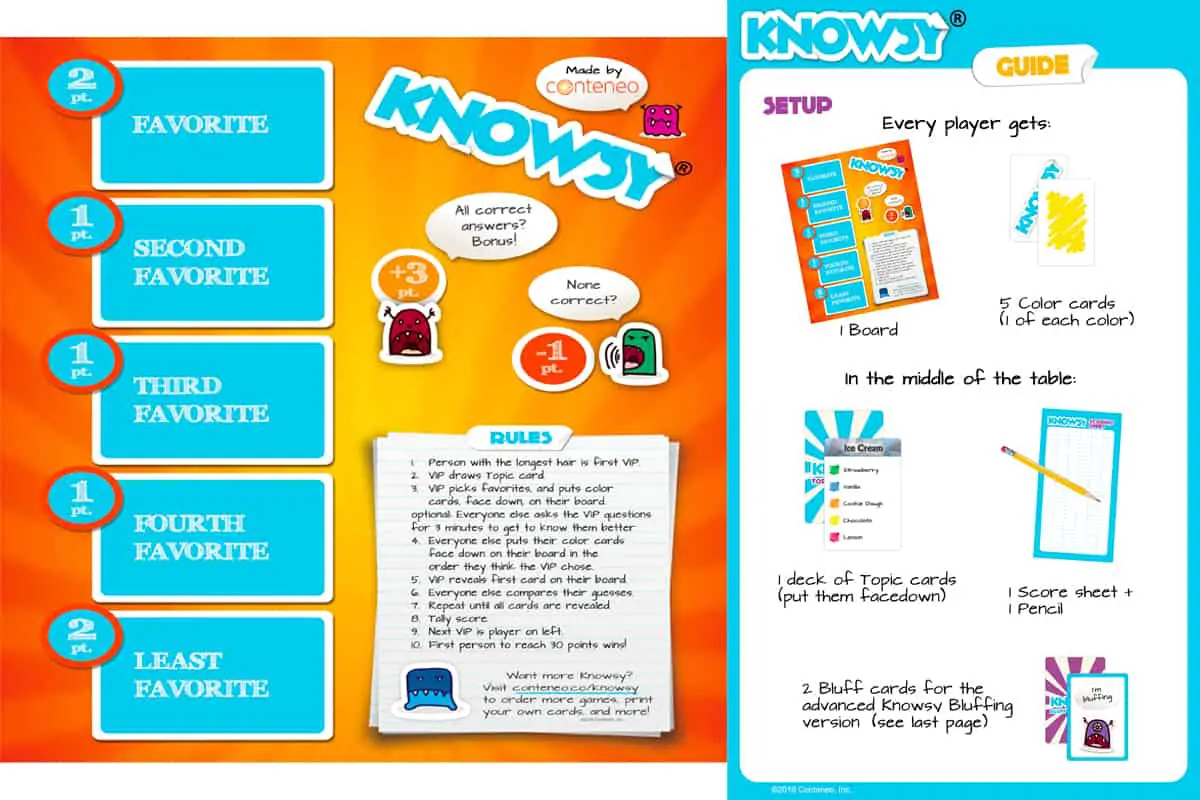
Age: 12+
Players: 2-6
Target: Adults & family
Duration: 30-60 minutes
Knowsy is a “print on demand” game, so it is not mainstream, but it has gained a following of local associations and even has inspired an online version aimed at training sales professionals (by Innovation Games).
is a “print on demand” game, so it is not mainstream, but it has gained a following of local associations and even has inspired an online version aimed at training sales professionals (by Innovation Games).
The principle of the game is for all the other players to try to guess the order of preference of one of the players (the “VIP”) between 5 everyday things that are listed on a “topic card” (there are 70 in the game). For instance, the “Ice cream” topic lists the following 5 toppings: strawberry, vanilla, cake dough, chocolate, and lemon.
Before guessing, the players can choose to have a 5 minutes discussion with the VIP to get to know him/her better and increase their odds of making the right choices.
The game works well because:
- The rule is very easy to understand
- All players play simultaneously (no wasted time “waiting” for other players)
- All discussions during the discussions might bring interesting information for the next rounds, so everyone listens a lot
- Everyone has his/her opportunity to answer questions, not only to ask
- It is the occasion to discover things you have in common with other players
- The principle is fun, as you can guess correctly or completely miss and guess the opposite of the truth about someone
Interestingly, even if the game is not precisely about building empathy (you are not guessing other people’s feelings or emotions, but rather their preferences), knowing other people’s tastes better does contribute to making you more empathetic (you get to understand things about them that you would have never learned without these conversations).
Most conversations we have with other people in our daily lives are not very informative. On the contrary, the whole duration of the game you will really get to know the other players better at a personal level.
Moreover, I highly recommend this game. Perhaps it would not be beneficial to play with your children (you already know them well), but rather with friends, cousins, neighbors or relatives that you do not know well.
It can also be played in organizations (companies, associations, etc.) to strengthen the links between their members.
Massachusetts Preschool Empathy Related Standard Competencies
| Code | Preschool | Kindergarten |
| SEL5.1 | Begin to recognize that people have different emotional reactions. | Distinguish others’ feelings. Begin to speculate on why they might be different. |
| SEL5.2 | Demonstrate awareness of others’ expressions of feelings | Recognize, label, and connect with others’ expression of feelings (explain reasons/causes) |
| SEL5.3 | Respond to another’s emotions and needs | Respond to another’s emotions and needs |
| SEL5.4* | Begin to anticipate others’ feelings and responses | Predict others’ feelings, responses, and behavior. Make decisions accordingly. |
*With Support
Edudingo.com is a participant in the Amazon Services LLC Associates Program, an affiliate advertising program designed to provide a means for sites to earn advertising fees by advertising and linking to Amazon.com. We also participate in other affiliate programs which compensate us for referring traffic.
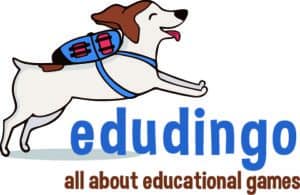


This is such a great list of board game to incorporate socioemotional learning into a curriculum for children. Have you heard of a new board game called Empower Empathy? Wondering what you think of it in comparison with rest of these.
https://tiny-sprouts.pledgemanager.com/projects/empower-empathy/participate/?ref=google